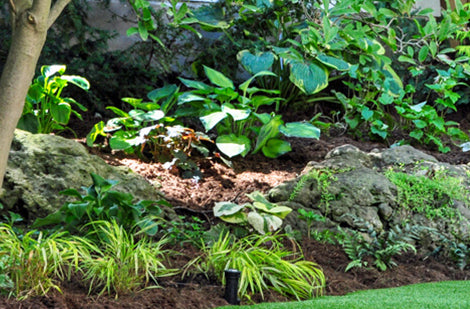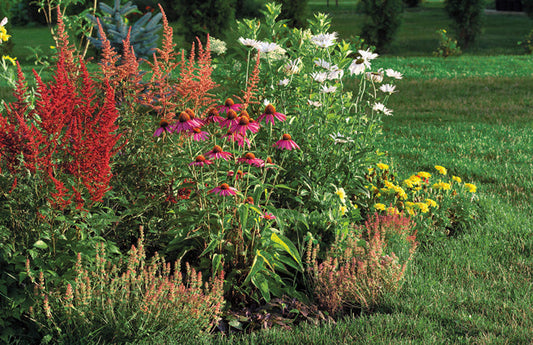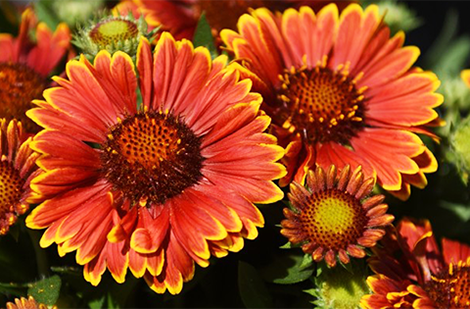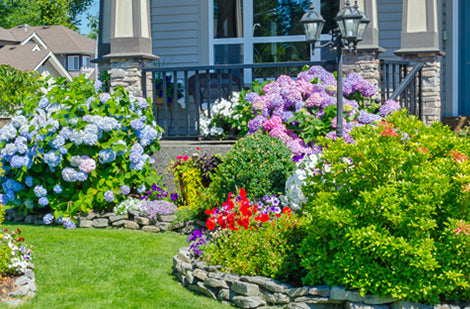Thymus pseudolanuginosus
Thymus pseudolanuginosus – Woolly Thyme
Thymus pseudolanuginosus – Woolly Thyme
Exposure
- Sun
Rusticity
Bloom time
- June
- Dense foliage
- Beautiful ground cover
- Full sun
- Small pink flowers
- Low odor leaves
Woolly Thyme is an exceptional perennial groundcover, prized for its unique texture and foolproof hardiness. It forms a soft, dense, silvery mat that hugs the contours of the ground, creating a soothing visual effect. Ideal for difficult, sunny spots, it tolerates light foot traffic and requires very little maintenance, making it a perfect solution for filling joints between flagstones or dressing up a rock garden.
Characteristics
- Foliage: The plant develops evergreen foliage, its main feature. The tiny, grey-green leaves are completely covered in fine white hairs, which gives them a soft, woolly appearance and texture.
- Flowering: In early summer, it produces a discreet and sparse bloom of tiny pink to lilac flowers. It is grown primarily for the beauty of its foliage.
- Light: It demands full sun to maintain its dense habit and beautiful silvery colour.
- Habit: It forms a very low, creeping mat that spreads across the ground.
- Growth: With a medium growth rate, it reaches a height of just 2 to 5 cm, but spreads to cover a diameter of 30 to 45 cm or more.
- Moisture: It prefers soil that dries out completely between waterings.
- Soil: It thrives in poor, gravelly, or sandy soils, as long as the drainage is impeccable. It hates standing water.
- Hardiness: Very hardy, it faces Zone 4 winters without difficulty, especially with good snow cover.
- Watering: Once established, it demonstrates exceptional drought tolerance and very rarely requires watering.
- Resistance: This robust plant resists deer, rabbits, and handles light foot traffic well, which is rare for a groundcover.
Uses
- Types of Use: It is the quintessential choice for planting between flagstones on a path, in the crevices of a stone wall, or in a rock garden. It can also serve as a lawn substitute in very small, dry areas.
- Ornamental Features: Its woolly texture and silvery grey-green colour create a soft, luminous mat that contrasts beautifully with stone. It brings softness and a touch of originality to the garden.
Care
- Fertilizing: It requires no fertilization and is content in poor soils.
- Pruning: Its maintenance is minimal. No pruning is required.
- Planting: Plant it in a very sunny location with soil that does not retain water.
Plant details
Dimensions
Dimensions
Characteristics
Characteristics
Habit:
- Bushy
- Spreading
Flowering colours:
- Pink
Plant needs
Plant needs
Watering:
- Low watering
Maintenance:
- Easy. No pruning necessary
- but you can remove wilted leaves as needed.
Soil requirement:
- Well-drained soil
- Dry
Features
Features
Resistance:
- Diseases
- Drought
Attract:
- Pollinators
Use:
- Ground cover
- Rockeries
- Flowerbeds
- Hanging pot
Attribute:
- Aromatic


Related articles
-

Perennials for all occasions
Read the articleOsez créer des associations inédites qui sauront refléter votre personnalité, même si pour cela vous deviez déplacer certaines vivaces pour mieux les mettre en valeur.
-

Landscaping with perennials
Read the articleVariétés à découvrir, la tomate se savoure crue, en sandwich, en bruschetta ou en salade. Cuite, c'est l'ingrédient de base de sauces, soupes et salsas.
-

Perennials proper maintenance: cut and fertilize
Read the articleLa grande popularité des vivaces vient du fait qu'après avoir été oubliées pendant des mois au cours de l'hiver, elles réapparaissent sur la scène plus énergiques et surprenantes que par...
-

How to plant perennials in your garden
Read the articleEn pénétrant au jardin, ce sont souvent les plantes vivaces que l’on remarque en premier. Un massif de sauges, d’hémérocalles, d’astilbes, d’échinacées ou de lavande offre un spectacle d’une beauté...










